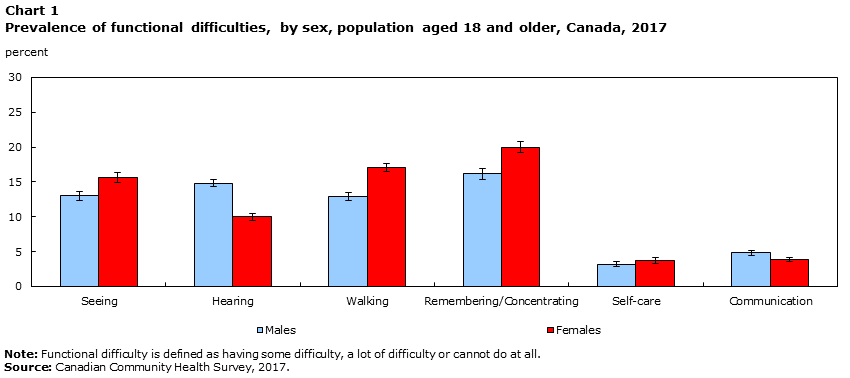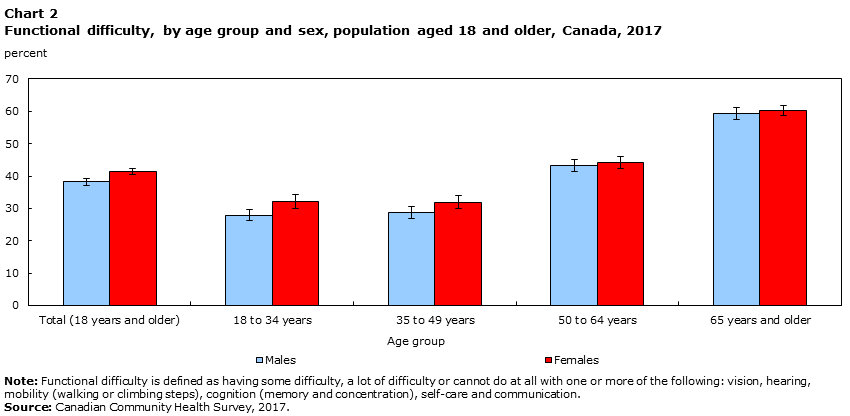Health Fact Sheets
Functional Difficulties: Washington Group, 2017
Archived Content
Information identified as archived is provided for reference, research or recordkeeping purposes. It is not subject to the Government of Canada Web Standards and has not been altered or updated since it was archived. Please "contact us" to request a format other than those available.
According to data from the 2017 Canadian Community Health Survey (CCHS), 18.1% of Canadians aged 18 and older had at least some difficulty remembering or concentrating, 14.3% had at least some difficulty seeing and 15.0% had difficulty walking (Chart 1).Note 1 Females were more likely than males to have difficulty with seeing, walking, remembering and self-care. Whereas males were more likely to have difficulty with hearing and communicating.Note 2

Data table for Chart 1
| Percent | Confidence Interval | ||
|---|---|---|---|
| Lower 95% limit | Upper 95% limit | ||
| Males | |||
| Seeing | 13.0 | 12.4 | 13.6 |
| Hearing | 14.8 | 14.2 | 15.4 |
| Walking | 12.9 | 12.3 | 13.5 |
| Remembering/Concentrating | 16.2 | 15.4 | 16.9 |
| Self-care | 3.2 | 2.9 | 3.5 |
| Communication | 4.8 | 4.4 | 5.2 |
| Females | |||
| Seeing | 15.6 | 14.8 | 16.3 |
| Hearing | 10.0 | 9.5 | 10.5 |
| Walking | 17.1 | 16.4 | 17.7 |
| Remembering/Concentrating | 20.0 | 19.3 | 20.8 |
| Self-care | 3.7 | 3.4 | 4.1 |
| Communication | 3.8 | 3.4 | 4.1 |
|
Note: Functional difficulty is defined as having some difficulty, a lot of difficulty or cannot do at all. Source: Canadian Community Health Survey, 2017. |
|||
The prevalence of functional difficulties differed by age group. In 2017, the proportion of Canadians with a functional difficulty increased between each age group from 35 to 49 to 65 and older. Among both sexes, the percentage reporting a functional difficulty was highest among those aged 65 and older. Among Canadians aged 65 and older, 59.8% had at least some difficulty in one or more domain of functional health (Chart 2).

Data table for Chart 2
| Age group | Percent | Confidence Interval | |
|---|---|---|---|
| Lower 95% limit | Upper 95% limit | ||
| Males | |||
| Total (18 years and older) | 38.2 | 37.3 | 39.2 |
| 18 to 34 years | 27.9 | 26.1 | 29.6 |
| 35 to 49 years | 28.7 | 27.0 | 30.5 |
| 50 to 64 years | 43.2 | 41.3 | 45.0 |
| 65 and older | 59.3 | 57.5 | 61.1 |
| Females | |||
| Total (18 years and older) | 41.3 | 40.4 | 42.2 |
| 18 to 34 years | 32.1 | 30.1 | 34.2 |
| 35 to 49 years | 31.9 | 30.0 | 33.9 |
| 50 to 64 years | 44.1 | 42.2 | 45.9 |
| 65 years and older | 60.3 | 58.6 | 61.9 |
|
Note: Functional difficulty is defined as having some difficulty, a lot of difficulty or cannot do at all with one or more of the following: vision, hearing, mobility (walking or climbing steps), cognition (memory and concentration), self-care and communication. Source: Canadian Community Health Survey, 2017. |
|||
In 2017, Canadians who have at least some difficulty in one or more domain of functional health were less likely to have obtained a post-secondary diploma or university degree (57.6%), compared with Canadians without any difficulty (72.4%).Note 3 Canadians with a functional difficulty were also less likely to have worked at a job or business in the past 12 months (66.7%), compared with 82.0% of people with no difficulties.Note 4
In 2017, 63.7% of Canadians aged 18 and older with a functional difficulty said that their sense of belonging to the local community was very strong or somewhat strong, compared with 71.0% of Canadians with no difficulties. The proportion of Canadians who reported that they were satisfied or very satisfied with life was also lower among those who experienced a difficulty (86.1%) than among those who experienced no difficulty (96.5%).
About Washington Group
The Washington Group (WG) on Disability Statistics was established by the United Nations to address the need for comparable statistics on disability cross-nationally and to address equalization of opportunities. The 2017 Canadian Community Health Survey (CCHS) used the WG Short Set on Functioning (WG-SS) which looks at six functional health components including vision, hearing, mobility (walking or climbing steps), cognition (memory and concentration), self-care and communication.Note 5 Note 6 The WG-SS in combination with other indicators, such as employment and education, can improve understanding of social inclusion for people with functional difficulties.
End of text box
- Date modified:

